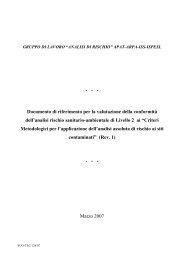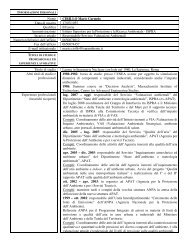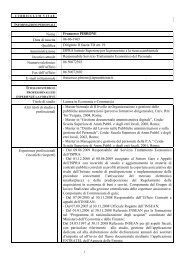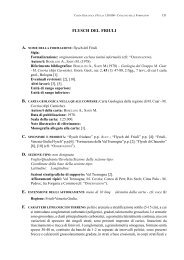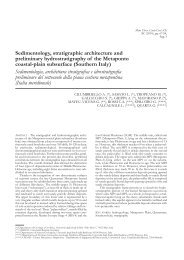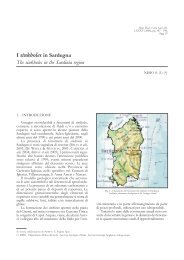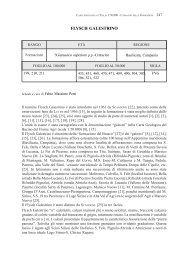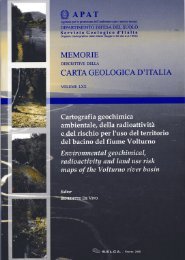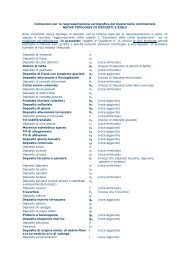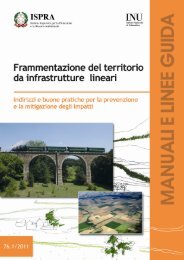Guidebook - Ispra
Guidebook - Ispra
Guidebook - Ispra
Create successful ePaper yourself
Turn your PDF publications into a flip-book with our unique Google optimized e-Paper software.
Volume n° 1 - from PR01 to B15<br />
B12<br />
B12 -<br />
Leader: M. Sandulescu<br />
the Subbucovinian sedimentary envelope, are well<br />
exposed (Săndulescu, 1975).<br />
In the S u b b u c o v i n i a n o u t l i e r the following lithostratigraphic<br />
succession can be examined : Anisian<br />
dolomites representing the main part of the outlier/<br />
Lower Jurassic (?) coarsegrained quartzites/Middle<br />
Jurassic sandy limestones with Trocholina div.sp.,<br />
Bositra buchi,Zeilleria div.sp., Parkinsona parkinsoni<br />
etc. Discordantly, thin bedded Tithonian limestones/<br />
limy polymictic breccias with inlayerings of marly<br />
limestones. Along the frontal part of the Bucovinian<br />
nappe such “Rabotage” Outliers crop out frequently<br />
(cf. Stop 2.1 too). Another lithostratigraphical succession<br />
with respect to the Gura Dămucului shows:<br />
Callovian-Oxfordian radiolarites, Tithonian-Neocomian<br />
pelagic limestones, with breccias inlayerings<br />
in the Neocomian. This two types of successions<br />
proceed from different parts of the Subbucovunian<br />
domain, with different paleogeographic evolutions. A<br />
third type of Subbucovinian lithostratigraphy may be<br />
considered the Putna Valley succession (Stop 1.10).<br />
The F r o n t a l p a r t of the Bucovinian Nappe is represented<br />
by metamorphic formations of the Tulgheș Series<br />
(sericitic-quartzitic and sericitic-graphitic schists<br />
with inlayerings of metabasalts and porphyroids).<br />
Stop 2.11:<br />
The External Limb of the Hăghimaș Syncline :<br />
At 1,5 km west from the Bucovinian front, upstream<br />
along the Bicaz Valley, the massive Anisian dolomites<br />
mark the outer limb of the Hăghimaș Syncline.<br />
Lower Triassic quartzitic sandstones discontinously<br />
develop at their base. A pre-Barremian or even - taking<br />
into account the general structure of the outer limb<br />
of the syncline – pre-Late Jurassic imbrication may<br />
be demonstrated on the left-hand bank of the Bicaz<br />
where a scale involving Middle Jurassic rocks may<br />
be examined. With an angular discordance, the Wildflysch<br />
Formation follows, with a similar lithologiy to<br />
that of the Rarău Syncline (see Stop 1.7).<br />
The Wildflysch Formation is tectonicaly overlapped<br />
by the outliers of the Hăghimaș Transylvanian Nappe<br />
(the big limestones quarries upstream from Stop<br />
2.11). Both Wildflysch Formation and Transylvanian<br />
Nappe are transgressively covered by the Bârnadu<br />
Conglomerates (Vraconian ? – Cenomanian) which<br />
constitute the Post-Tectogenetic Cover. The conglomerates<br />
crop out along the road 2 km upstream from<br />
the quarries. The Hăghimaș Transylvanian Nappe can<br />
be examined in the Bicaz Gorges (Cheile Bicazului)<br />
upstream until the eastern margin of the touristic lo-<br />
cality of Lacu Roșu.<br />
Stop 2.12:<br />
Bicaz Gorges (confluence with the Bicăjel Brook).<br />
In the area of the confluence between the Bicaz with<br />
the Bicăjel the Tithonian-Neocomian succession<br />
of the Hăghimaș Nappe is exposed (Săndulescu,<br />
1975). The Tithonian is represented by massive<br />
light coloured neritic limestones which contain<br />
gastropods (Nerinea), foraminiferas (Trocholina<br />
alpina, T.elongata, Kurnubia, Kilianina, etc.), calcareous<br />
algae (Salpingoporella anulata) as well as<br />
Elipsactinia, Cladocoropsis mirabilis, Clypeina<br />
div.sp., Actinoporella podolica etc. The Berriasian<br />
is represented by well layered pelagic limestones<br />
with Calpionella elliptica, Tintinopsella carpathica,<br />
Calpionellopsis oblonga, Neocomites neocomiensis,<br />
Berriassiella privasensis. The Neocomian has a similar<br />
lithology (massive neritic limestones) and follows<br />
clearly above the Berriasian formations. Downstream<br />
from the confluence (about 600 m ), the Neocomian<br />
limestones are covered, with a slight discordance,<br />
by Urgonian-type ones (white, yellowish and light<br />
reddish limestones and calcarenitic breccias which<br />
contain Pachyodonts [Requienia div.sp. Toucasia<br />
carinata], large foraminiferas [Orbitolina conica] as<br />
well as calcareous algae and briozoarians; the age of<br />
these limestones is at least Lower Barremian, possibly<br />
Barremian as a whole but not younger because they<br />
are inbedded as sedimentary klippen in ([Upper Barremian<br />
??] Aptian formations of the Wildflysch).<br />
Stop 2.13:<br />
“Cheile Bicazului” Tectonic Half - Window.<br />
On the left-hand (northern) slope of the Bicaz River<br />
around the Chalet “Cheile Bicazului” (Bicaz Gorges)<br />
erosion has exposed a tectonic half-window from<br />
which the Wildflysch Formation crops out below the<br />
Hăghimaș Nappe. At the base of the latter, bodies of<br />
mafic and ultramafic rocks emplaced (Săndulescu<br />
and Russo-Săndulescu, 1981). Along the left-hand<br />
bank of the Bicaz River the following succession<br />
may be examined: above the Wildflysch, pillow-lava<br />
basalts and amygdaloid basalts, overlapped by siltic<br />
siliceous shales and red marls (Kimmeridgian), representing<br />
the first sedimentary levels above the Middle<br />
Jurassic oceanic crust. The succession continues with<br />
the massive Tithonian limestones. On the left-hand<br />
slope of the Bicaz River, 300 m behind the Chalet<br />
at the base of the Hăghimaș Nappe are transported<br />
serpentinites which also proceed from the obducted



